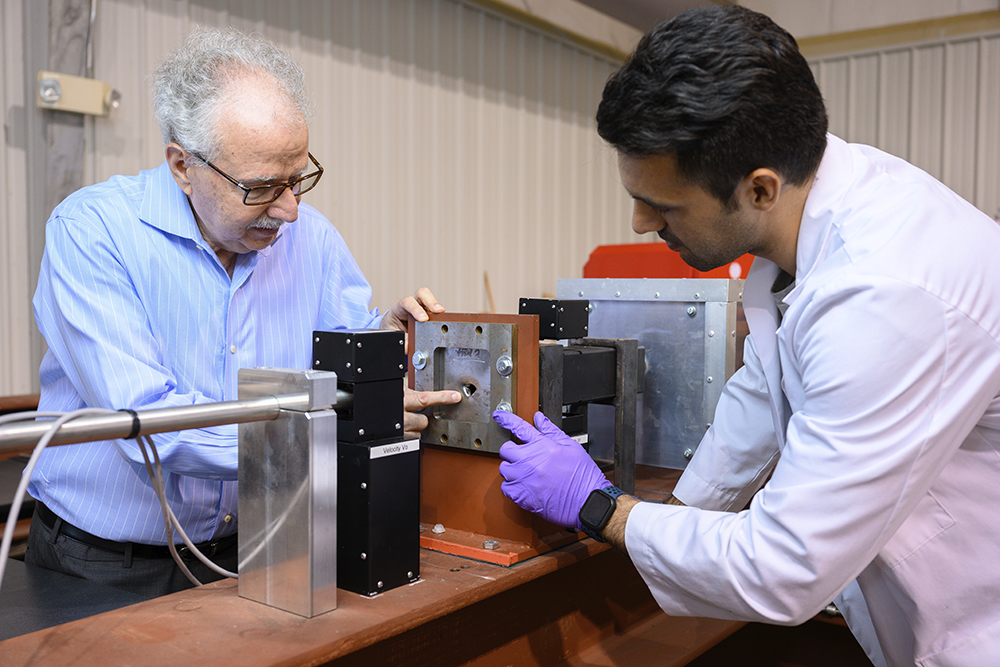LSU Civil Engineering PhD Student Researches Lithium Battery Safety
 December 21, 2023
December 21, 2023
BATON ROUGE, LA – Lithium-ion batteries are used in many popular products today, such as cell phones, toys, appliances, electric vehicles, and even electrical energy storage systems. As the demand for these lithium-powered products grows, so does concern for consumer safety. LSU Civil and Environmental Engineering (CEE) PhD student Edris Akbari is working with his doctoral advisor, LSU CEE Department Chair and Boyd Professor George Voyiadjis, to enhance safety considerations and propel advancements in predictive models for the mechanical behavior of lithium-ion battery (LIB) cells.
Lithium-ion batteries combine a flammable electrolyte with stored energy. If the LIB cell creates more heat than it can effectively disperse, it can lead to a rapid uncontrolled release of heat energy known as “thermal runaway” that can result in a fire or explosion, according to the Fire Protection Agency. This can happen when lithium-ion batteries are damaged or not stored or charged properly. The best way to prevent this from happening in the first place is to have a safer battery.
Akbari is conducting research in LSU’s Computational Solid Mechanics Laboratory (CSM) and the Material Under Extreme Loading Laboratory (MATEX), the latter of which has played a crucial role in his research, providing a conducive environment for studying blast and hypervelocity projectile penetration behavior and valuable insights into now stress and strain affect pouch cells. Akbari’s studies also include indentation (quasi-static) in the Microstructural Characterization Lab (MICL).
“The CSM Lab has also been very helpful in improving the understanding of how materials react to extreme loading conditions by using non-traditional theories of visco-plasticity and damage,” Akbari said.
The novel analytical approach introduced in Akbari’s work incorporates a groundbreaking definition of the contact area between the cylindrical indenter and the cylindrical LIB cell. Notably, the analytical model was rigorously validated through an inverse finite element model coupled with optimization techniques. The optimization results unequivocally demonstrate the accuracy of this analytical method in capturing the stress-strain curve, marking a significant advancement in the field. In addition to this specific study, this broader research extensively explores the mechanical behavior of LIB cells, with a specific focus on Lithium Nickel, Manganese Cobalt Oxide (NMC), and Lithium Iron Phosphate (LFP) types.
Akbari’s work does not stop at understanding the mechanical intricacies of LIB cells. It also addresses a significant discrepancy observed when transitioning from a single cell to a stack of two cells. This research seeks to interpret the underlying reasons for the substantial reduction in force during such transitions, providing valuable insights into the mechanical behavior of stacked cells.
Complementing these computational efforts, the research conducts mechanical experimental tests to validate and refine the developed computational models. These experiments provide tangible data points that enhance the accuracy and reliability of their predictions, creating a synergistic relationship between computational simulations and real-world observations.
“This research contributes significantly to the understanding of LIB cell behavior under various loading conditions and holds promise for applications in diverse fields requiring safe and efficient energy storage solutions,” Akbari said.
Like us on Facebook (@lsuengineering) or follow us on Twitter and Instagram (@lsuengineering).
###
Contact: Libby Haydel
Communications Manager
225-578-4840
ehaydel1@lsu.edu